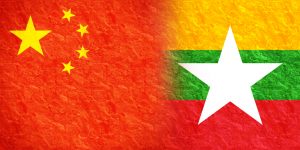Sebastian Strangio

Yesterday, The Irrawaddy magazine published an article detailing the recent rise in anti-Chinese incidents in Myanmar, following the visit of Chinese Foreign Minister Qin Gang to the country at the start of May.
According to the report, Qin’s visit, the first by a top-level Chinese government official since the coup, was followed by spotfire protests across the country, airing the widely felt grievances about China’s engagement with the military junta. These included a demonstration in Letpadaung, Sagaing Region, the site of a controversial China-backed copper mine, during which protesters burned a Chinese flag.
Similar symbolic immolations took place in Magwe, Yangon, Mandalay, and elsewhere in Sagaing, where resistance groups burned Chinese flags along with pictures of Qin and junta chief Min Aung Hlaing, while hoisting banners calling on Beijing to stop “supporting fascist criminals” and to “respect the Myanmar people’s voice.”
The Irrawaddy also quoted a member of the General Strike Coordination Body (GSCB), an anti-regime group, as saying that resistance forces would “step up our protests” against China’s collusion with the hated military administration. “As long as the Chinese government continues to support the regime and stand by it publicly, we will continue to organize anti-China protests, not only in Myanmar but also in foreign countries together with Myanmar expats there,” the GSCB member said.
During his one-day visit to Myanmar on May 2, my colleague Shannon Tiezzi noted at the time, Qin held talks with junta chief Senior Gen. Min Aung Hlaing during which he pledged “deepen practical cooperation in such fields as economy and livelihood, and support Myanmar’s efforts to maintain stability, revitalize the economy, improve people’s lives, and realize sustainable development,” according to a statement from China’s Foreign Ministry. In the context of the ongoing armed resistance against the coup government, it also pledged to “support Myanmar’s efforts to maintain stability.”
Curiously, the Chinese foreign minister also paid a call on former military dictator Than Shwe, during which the latter expressed hope that Myanmar and China would retain their longstanding “pauk-phaw” friendship – a special term that the two nations use to refer to their relationship (at least in good times).
The protests lay bare the deep popular discontent about China’s engagement with, and increasing support of, the military junta that seized power in a coup in February 2021. While China initially hedged its bets, by the middle of 2021 it appeared to have accepted the coup as a fait accompli.
It has since stepped slowly back toward full engagement with the military in the pursuit of its core strategic interests in Myanmar: in particular, its long-held desire to open up an overland transport corridor from Yunnan province to Myanmar’s coast on the Bay of Bengal.
Underpinning this return to business as usual is a ruthlessly pragmatic assessment: that for all the efforts of the nationwide resistance, the military junta is unlikely to collapse any time soon – and that therefore, China needs to work within the existing political realities. As Tiezzi noted at the time of Qin’s visit, “Beijing seems to be pretending that the coup, in effect, didn’t happen.”
To be sure, Beijing’s accommodative policy comes with its share of risks. This month’s protests suggest that for the country’s resistance, and indeed for much of the population at large, China’s reputation, never positive in even the best of times, is plumbing new lows. Should the opposition National Unity Government prevail in its struggle, China will have to account for its support for a brutal military dictatorship.
While this would not hold it back indefinitely – the NUG, like Aung San Suu Kyi’s National League for Democracy before it, recognizes that China is a necessary partner of any Myanmar government – China’s poisonous reputation among the Myanmar public looms as a long-term liability.
No comments:
Post a Comment